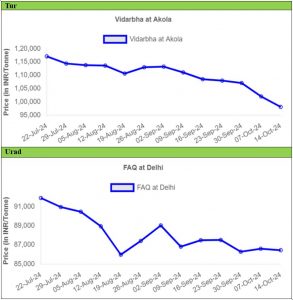Prices of Tur and Urad in major mandis had declined on an average 10% over the past three months. Mandi prices of most pulses are on declining trend in recent months due to improved availability and higher Kharif pulses sowing area this year.
However, at same time it noticed that retail prices of these pulses have not seen a similar decline. While Chana prices were declined in past month, but retail prices continue to increase.
The Department of Consumer Affairs’ Secretary, Smt. Nidhi Khare, stated that the divergence patterns in wholesale and retail mandi prices are a sign that merchants are taking unfair advantage of the dynamics of the market to extract ever-larger margins. The patterns are being continuously monitored, and if it is discovered that the divergences are getting wider, appropriate action will need to be taken.
Regarding availability, the Secretary of Consumer Affairs reported that imports of Tur and Urad from East African nations and Myanmar are gradually increasing to supplement domestic production, while Kharif Urad and Moong have begun to appear in the markets. The quantity of pulses stock declared by big-chain shops on the Department of Consumer Affairs’ stock declaration portal has been rising every week, which further indicates the favorable domestic availability condition.
Considering the current availability situation and easing of mandi prices, Secretary asked retail industry to extend all possible support to the Government in its efforts to keep prices of dals affordable to the consumers. In this regard, she invited organized retail chains to coordinate with NCCF and NAFED in the distribution of Bharat Dals, especially Bharat Masur Dal and Bharat Moong Dal, to widen and deepen the coverage and reach of Bharat Dals among consumers.

Source: PIB